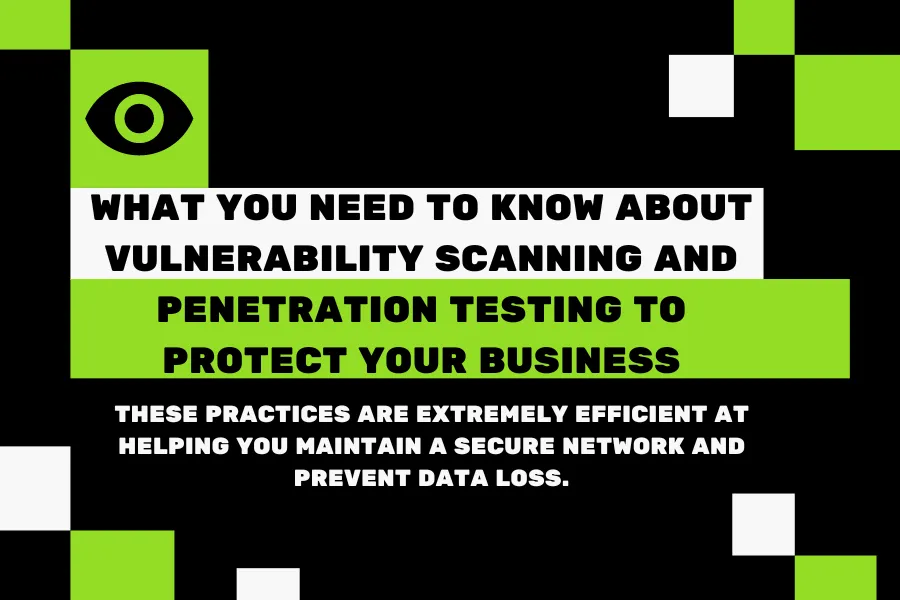Blog
Business IT articles and News

What You Need to Know About Vulnerability Scanning and Penetration Testing to Protect Your Business
What You Need to Know About Vulnerability Scanning and Penetration Testing to Protect Your Business
Effectively implementing these measures can provide protection to your network and guard against any loss of data.
Introduction
Vulnerability scanning and penetration testing are essential IT security measures to protect your business from cyber threats. Vulnerability scanning is the process of identifying, quantifying, and prioritizing (ranking) security vulnerabilities in the IT environment, such as software, hardware, and networks. Penetration testing, on the other hand, is a simulated attack on your system or network to identify and address any potential vulnerabilities before malicious actors can exploit them. This blog post will provide an overview of both vulnerability scanning and penetration testing and how they can help protect your business.
Understanding Vulnerability Scanning
In the ever-evolving landscape of cybersecurity, vulnerability scanning has emerged as a crucial practice to ensure the safety and security of your business. Vulnerability scanning refers to the process of proactively identifying, assessing, and prioritizing potential vulnerabilities in your IT infrastructure. By regularly conducting vulnerability scans, you can stay one step ahead of cyber threats and take proactive measures to protect your business from potential breaches.
One key benefit of vulnerability scanning is that it allows you to uncover weaknesses and vulnerabilities in your software, hardware, and network infrastructure. By identifying these vulnerabilities, you can understand the potential entry points for attackers and take appropriate steps to mitigate the risks. Whether it's outdated software, misconfigured settings, or weak passwords, vulnerability scanning can help you identify and address these issues before they are exploited by malicious actors.
Furthermore, vulnerability scanning plays a vital role in compliance with industry regulations such as HIPAA. The Health Insurance Portability and Accountability Act (HIPAA) sets strict standards for protecting sensitive healthcare information. By conducting vulnerability scans, healthcare organizations can identify any weaknesses in their systems and ensure they are compliant with HIPAA requirements. This not only protects patient data but also helps avoid hefty fines and legal repercussions.
Vulnerability scanning is not a one-time task; it should be an ongoing practice. As new vulnerabilities are constantly being discovered and patched, regular scans are essential to keep your business secure. Additionally, it is important to note that vulnerability scanning is just the first step in the larger process of IT security. It provides you with valuable insights, but it's up to you to take action and address the vulnerabilities identified.
Schedule Your Free HIPAA Audit Today
Exploring Penetration Testing
Penetration testing, also known as ethical hacking or white-hat hacking, is a proactive approach to assessing the security of your systems and networks. Unlike vulnerability scanning, which focuses on identifying vulnerabilities, penetration testing takes it a step further by simulating real-world attacks to see how your defenses hold up.
During a penetration test, skilled cybersecurity professionals attempt to exploit vulnerabilities in your IT infrastructure, just as a malicious hacker would. This can involve various techniques, such as social engineering, network scanning, password cracking, and attempting to bypass security controls. The goal is to gain unauthorized access to your systems, data, or network resources.
By conducting penetration tests, you can identify any weaknesses that might be present in your security controls and gain insights into the potential impact of a successful attack. This allows you to take corrective actions to strengthen your defenses and mitigate any risks before they are exploited by cybercriminals.
Penetration testing can be conducted in different forms, depending on the scope and objectives. For example, you can choose to perform an external penetration test, which focuses on assessing your perimeter defenses from outside your network. Alternatively, you can opt for an internal penetration test, which evaluates the security of your internal network and systems.
One of the key benefits of penetration testing is that it provides a realistic evaluation of your security posture. It goes beyond vulnerability scanning by demonstrating how attackers might exploit multiple vulnerabilities in combination to gain access to sensitive information or disrupt your business operations. By simulating real-world attacks, you can better understand the potential consequences and take proactive measures to strengthen your defenses.
However, it's important to note that penetration testing should be conducted by experienced professionals who follow ethical guidelines and ensure that no harm is done to your systems or data. This ensures that the testing is controlled and does not cause any disruptions or unauthorized access.
In the next section, we will explore the differences between vulnerability scanning and penetration testing to provide a better understanding of how these two practices complement each other in securing your business.
Differences between Vulnerability Scanning and Penetration Testing
When it comes to securing your business against cyber threats, vulnerability scanning and penetration testing are two key practices to consider. While they both serve the purpose of identifying and addressing security vulnerabilities, there are distinct differences between the two.
Vulnerability scanning focuses on the identification and assessment of vulnerabilities in your IT infrastructure. It is a proactive approach that involves scanning your systems, software, and networks to uncover weaknesses. Think of it as a thorough check-up for your digital assets. By regularly conducting vulnerability scans, you can stay on top of potential risks and take the necessary steps to address them before they are exploited by malicious actors.
On the other hand, penetration testing takes vulnerability scanning to the next level by simulating real-world attacks on your systems and networks. It goes beyond identifying vulnerabilities and aims to test the effectiveness of your security measures in defending against such attacks. Skilled cybersecurity professionals attempt to exploit vulnerabilities just as a hacker would, utilizing techniques like social engineering and password cracking to gain unauthorized access to your systems. By doing so, they can provide valuable insights into the potential impact of a successful attack and help you strengthen your defenses accordingly.
While vulnerability scanning focuses on identifying vulnerabilities and prioritizing them, penetration testing puts these vulnerabilities to the test and evaluates the effectiveness of your security controls. Vulnerability scanning can be seen as a preventative measure to identify weaknesses, while penetration testing is a proactive measure to evaluate your ability to withstand real-world attacks.
In summary, vulnerability scanning is like a check-up to identify weaknesses, and penetration testing is a stress test to evaluate your defenses against real attacks. By utilizing both practices, you can gain a comprehensive understanding of your security posture and take proactive steps to protect your business.
Benefits of Conducting Vulnerability Scanning and Penetration Testing
Vulnerability scanning and penetration testing are not just proactive measures to protect your business from cyber threats; they also come with a multitude of benefits. By conducting regular vulnerability scans and penetration tests, you can enhance the security posture of your organization and safeguard your valuable assets.
One of the key benefits of vulnerability scanning is the ability to identify and prioritize vulnerabilities in your IT infrastructure. By understanding the weaknesses in your software, hardware, and network, you can take immediate action to address them before malicious actors exploit them. This helps to minimize the risk of data breaches, unauthorized access, and other cyber attacks.
Similarly, penetration testing offers numerous advantages for your business. By simulating real-world attacks, penetration tests can provide valuable insights into the effectiveness of your security measures. This enables you to identify any gaps or weaknesses in your defenses and take proactive steps to mitigate them. By uncovering vulnerabilities and testing your system's response to attacks, you can fortify your security controls and reduce the likelihood of successful breaches.
Furthermore, conducting vulnerability scanning and penetration testing demonstrates your commitment to cybersecurity and protecting your business assets. It enhances your credibility among clients, partners, and stakeholders who rely on your ability to safeguard sensitive data. Demonstrating a proactive approach to security can also give you a competitive edge in the market, as customers prioritize businesses that prioritize their data protection.
Another benefit is compliance. Vulnerability scanning and penetration testing play a vital role in meeting regulatory requirements in various industries. By regularly conducting these security assessments, you can ensure that you are meeting industry standards and avoid potential fines or legal repercussions.
Overall, the benefits of vulnerability scanning and penetration testing cannot be overstated. These practices provide you with valuable insights, enable you to fortify your security measures, enhance your credibility, and ensure compliance with industry regulations. By investing in these essential IT security measures, you can protect your business from cyber threats and safeguard your valuable assets.
Schedule Your Free HIPAA Audit Today
Best Practices for Vulnerability Scanning and Penetration Testing
When it comes to vulnerability scanning and penetration testing, following best practices is crucial to ensure the effectiveness and success of these security measures. Here are some key best practices to consider when conducting vulnerability scanning and penetration testing:
1. Define Clear Objectives: Before starting any scanning or testing, it is essential to clearly define your objectives. Determine what you want to achieve through the vulnerability scanning and penetration testing process. Whether it's identifying specific vulnerabilities, evaluating the effectiveness of security controls, or meeting compliance requirements, having clear objectives will help guide your efforts.
2. Conduct Regular Scans and Tests: Vulnerability scanning and penetration testing should be ongoing processes, not one-time events. Cyber threats are constantly evolving, and new vulnerabilities are being discovered regularly. By conducting regular scans and tests, you can stay ahead of potential risks and ensure the continuous security of your systems and networks.
3. Use the Right Tools: Utilize reliable and up-to-date vulnerability scanning and penetration testing tools. There are various commercial and open-source tools available that can help you automate and streamline the scanning and testing processes. Choose tools that are suitable for your specific needs and provide accurate and comprehensive results.
4. Involve Experienced Professionals: Vulnerability scanning and penetration testing require a high level of expertise and technical knowledge. It is recommended to involve experienced cybersecurity professionals who have the skills and experience to conduct these assessments effectively. They can provide valuable insights, interpret the results accurately, and guide you in implementing necessary security measures.
5. Follow Ethical Guidelines: Ensure that vulnerability scanning and penetration testing are conducted ethically and within legal boundaries. It is essential to obtain proper authorization from the relevant stakeholders before performing any scanning or testing. Additionally, be mindful of the potential impact on the systems and data being tested, and take precautions to avoid any disruptions or unauthorized access.
6. Document and Report Findings: Document all the findings and observations from the vulnerability scanning and penetration testing processes. This includes identifying vulnerabilities, their severity levels, and recommended remediation steps. Use clear and concise language in the reports to facilitate understanding by non-technical stakeholders.
7. Implement Remediation Measures: Once vulnerabilities and weaknesses are identified, it is crucial to take prompt action to address them. Implement the necessary remediation measures recommended by the vulnerability scanning and penetration testing reports. This may involve patching software, updating configurations, or strengthening security controls.
By following these best practices, you can ensure that vulnerability scanning and penetration testing are conducted effectively and help enhance the overall security posture of your organization.




